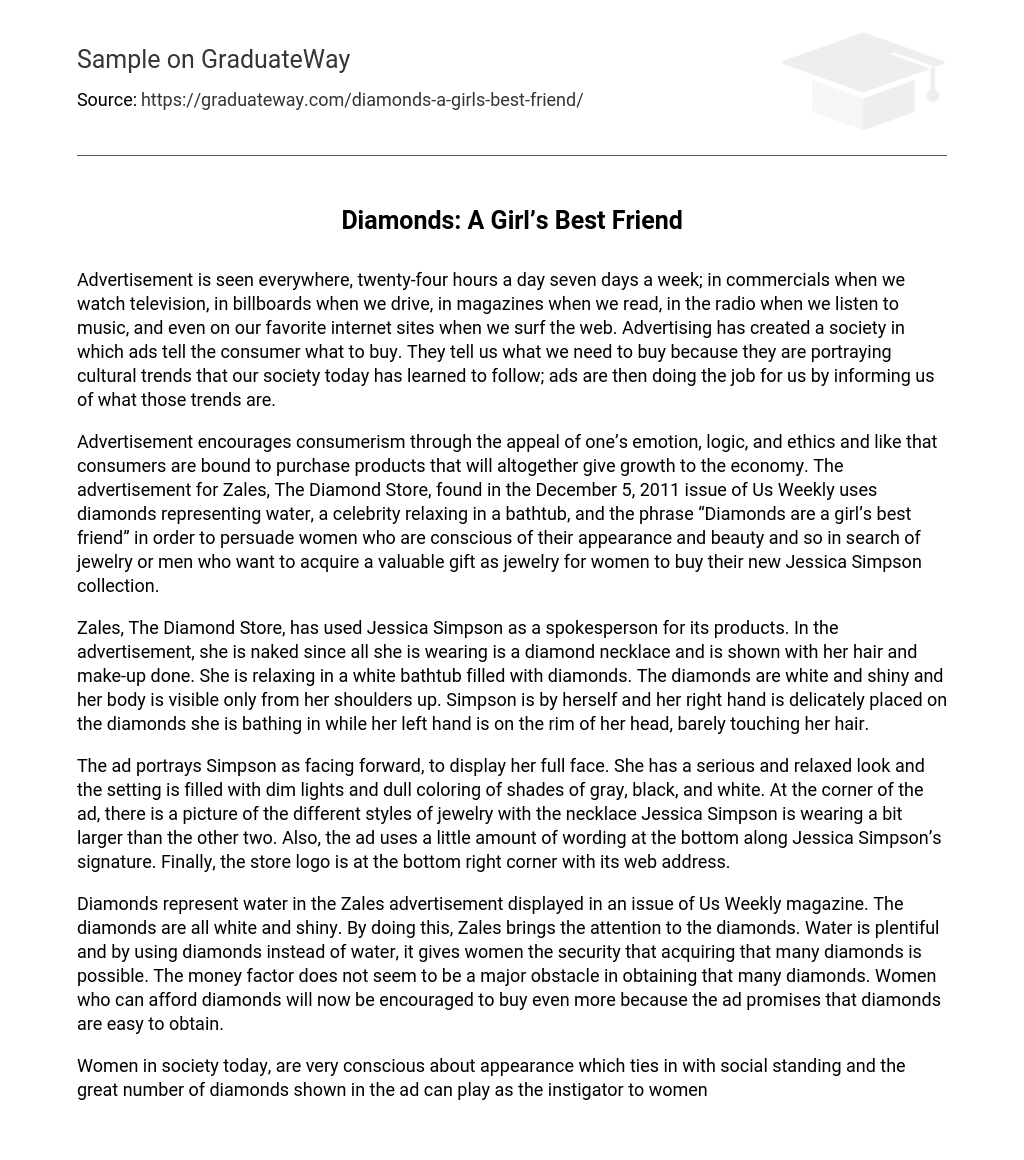Advertisement is ubiquitous, occurring around the clock and every day of the week. Whether it’s in TV commercials, billboards, magazines, radio, or even on our beloved internet sites, advertising has shaped a society where consumers are dictated what to purchase. By embodying cultural trends, these ads influence our buying decisions, effectively informing us of the trends we should be following.
The advertisement in the December 5, 2011 issue of Us Weekly for Zales, The Diamond Store, utilizes various strategies to promote consumerism. By appealing to emotions, logic, and ethics, the ad encourages consumers to purchase products that contribute to economic growth. The ad showcases diamonds symbolizing water and features a celebrity relaxing in a bathtub. Additionally, the phrase “Diamonds are a girl’s best friend” is used to influence women who prioritize their appearance and seek out jewelry. It also targets men who want to buy valuable gifts for women, endorsing Zales’ new Jessica Simpson collection.
Zales, The Diamond Store, has featured Jessica Simpson as a spokesperson, showcasing their products. In the advertisement, she appears nude except for a diamond necklace, with her hair and makeup elegantly done. The setting depicts her in a luxurious white bathtub filled with dazzling white diamonds. Only her shoulders and above are visible, as she is immersed in the sparkling bath. Simpson is depicted alone, gracefully resting her right hand on the diamonds she is bathing in, while delicately touching her hair with her left hand.
The advertisement features Jessica Simpson with a serious and relaxed expression, facing forward to display her entire face. The background is filled with dim lights and a muted color palette consisting of gray, black, and white. In one corner of the ad, there is an image showcasing different styles of jewelry, where Jessica Simpson’s necklace appears slightly bigger than the rest. Moreover, at the bottom, there is minimal text accompanied by Jessica Simpson’s signature. Finally, the store’s logo and web address are positioned in the bottom right corner.
Zales presents an advertisement in a recent issue of Us Weekly magazine where diamonds symbolize water. The advertisement showcases sparkling and flawless diamonds, captivating the viewer’s attention. By replacing water with diamonds, Zales suggests that owning multiple diamonds is achievable. Financial limitations seem to have no impact on obtaining numerous diamonds. Consequently, women who have the means to purchase diamonds are likely to be encouraged by the advertisement’s message that acquiring diamonds is effortless.
The Zales ad leverages the power of diamonds as a symbol of beauty and social status in today’s society. By showcasing an abundance of diamonds, it persuades women to acquire a significant quantity of these precious stones, aligning themselves with others. This implies that owning multiple diamonds is not only possible but also a valuable investment. The clever use of diamonds as a substitute for water in the advertisement resonates particularly well with women who value their appearance, urging them to make jewelry purchases.
On the other hand, the use of diamonds also serves the purpose of attracting heterosexual men who are looking to purchase a gift for a woman. The presence of Jessica Simpson bathing in diamonds can greatly capture the attention of men. Whether she is naked or not, Jessica’s sex appeal is undeniable. The diamonds cover her body, with only her shoulders visible. In the mind of a heterosexual male, he may envision his significant other also bathing if he buys her this jewelry.
The advertisement from Zales featuring Jessica Simpson aims to persuade men to buy their jewelry as gifts for women. The ad suggests that buying this jewelry will make the woman receiving it feel relaxed, as demonstrated by Simpson’s own relaxation. Additionally, the abundance of diamonds in the ad implies that men should continue buying Zales jewelry for women. The ad uses Simpson’s presence and image to encourage others to purchase the product. Although there may be other features in the ad, these aspects are crucial for its overall effectiveness in targeting a specific consumer. The variety of jewelry displayed at the bottom of the ad promotes personalization and a diverse selection.





